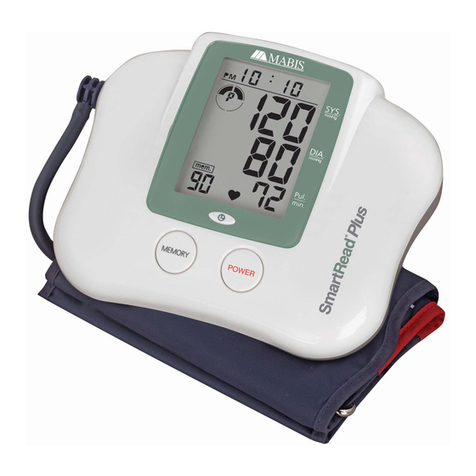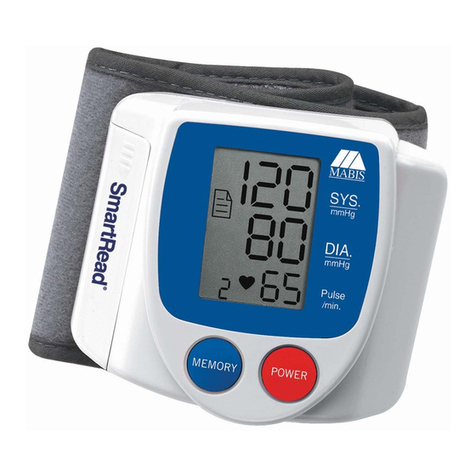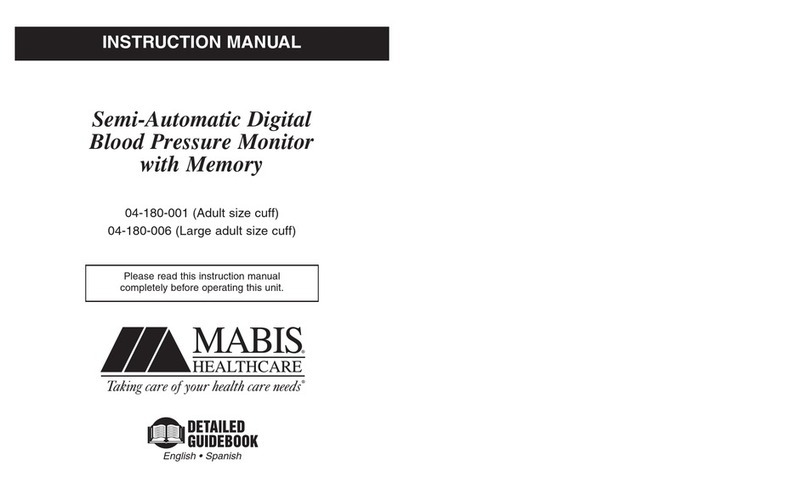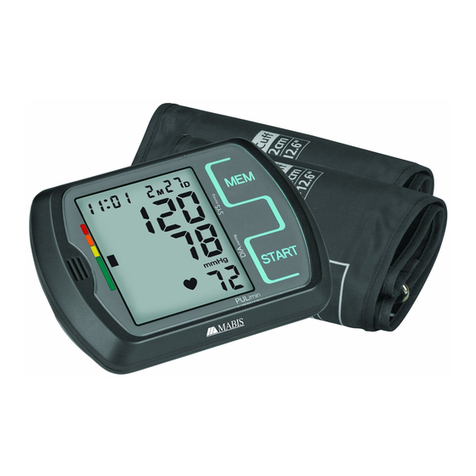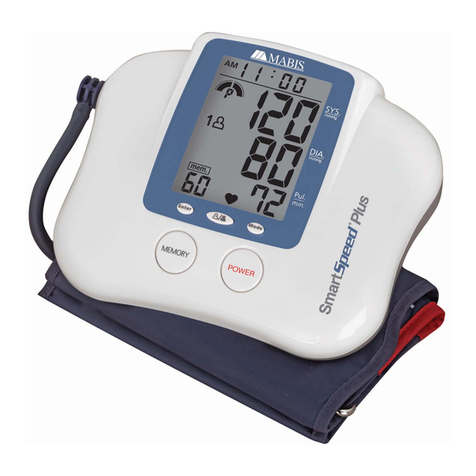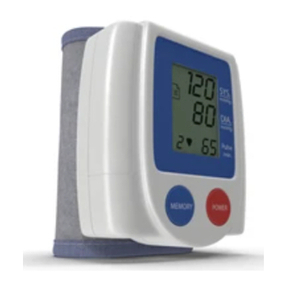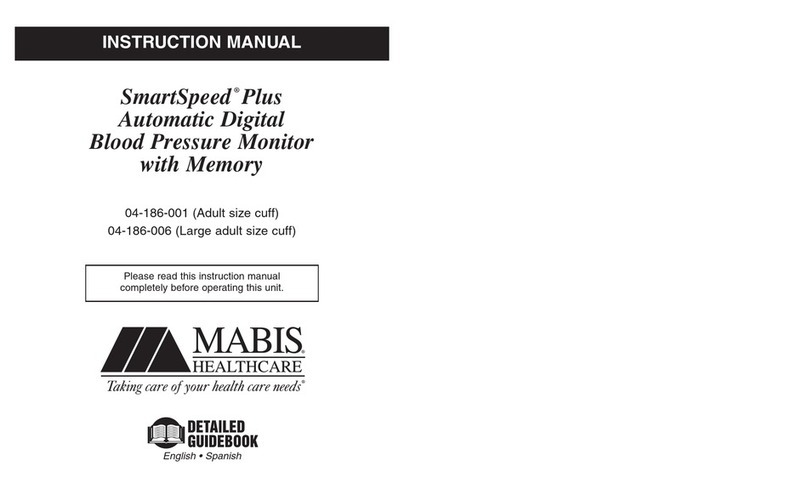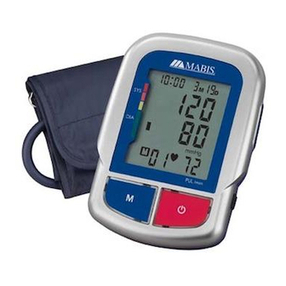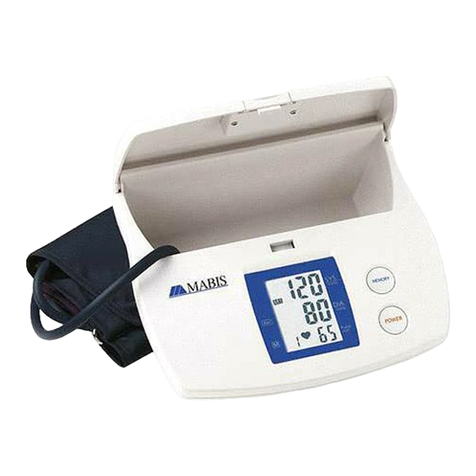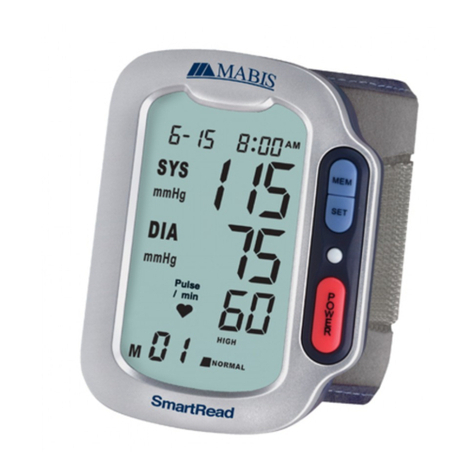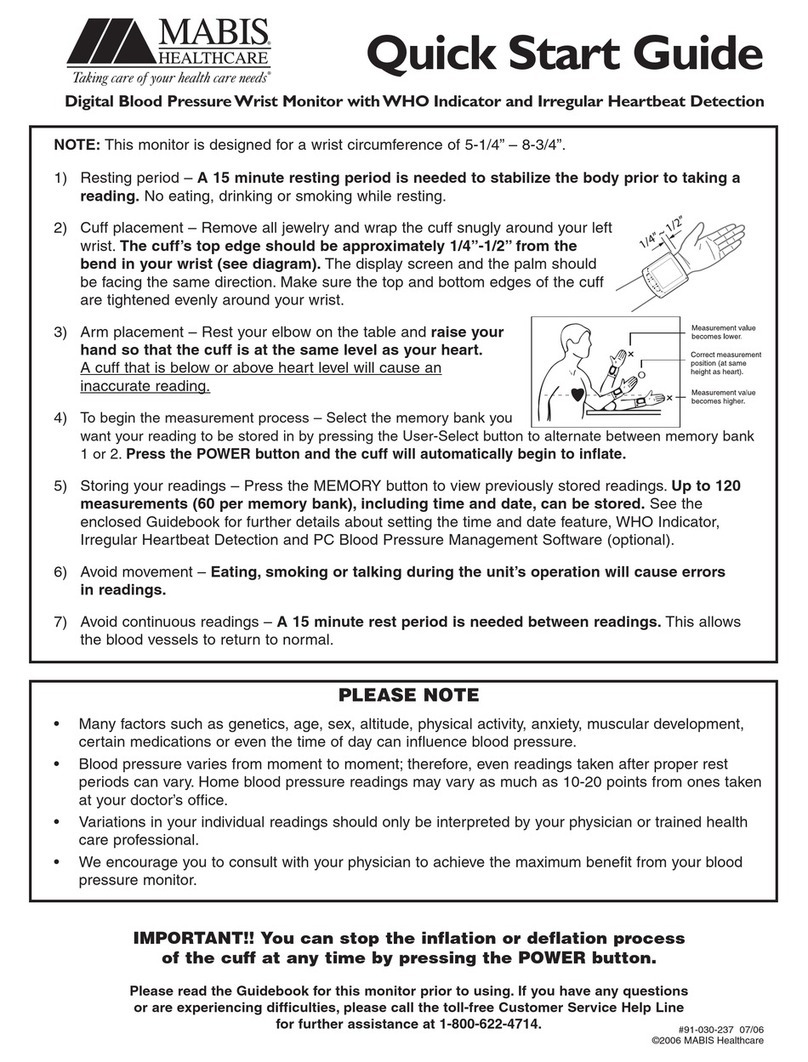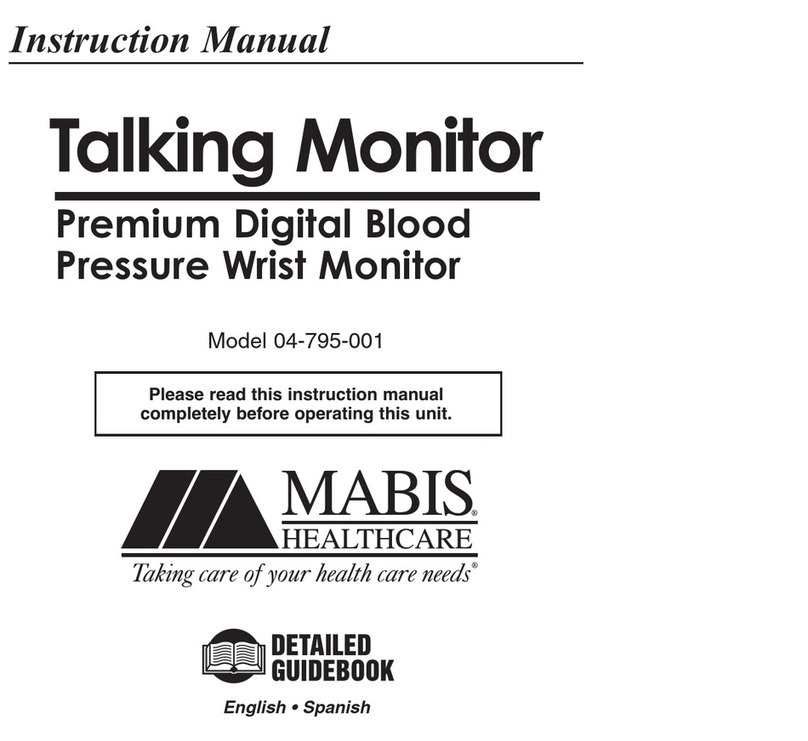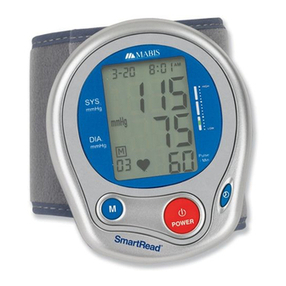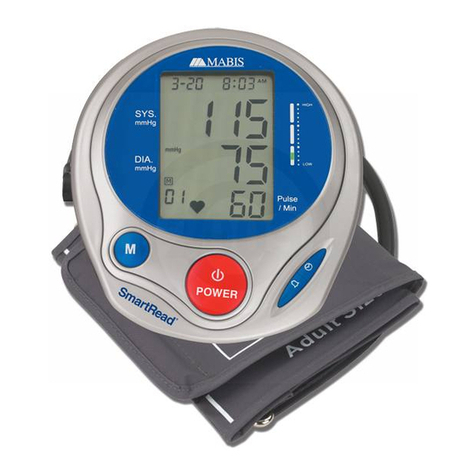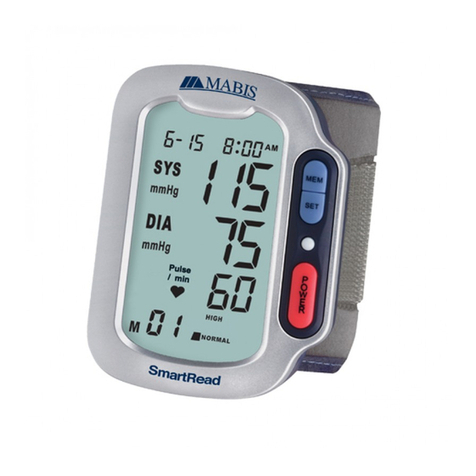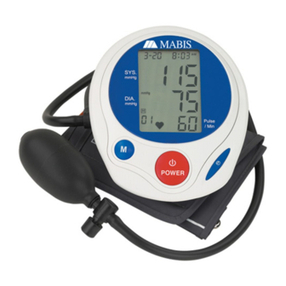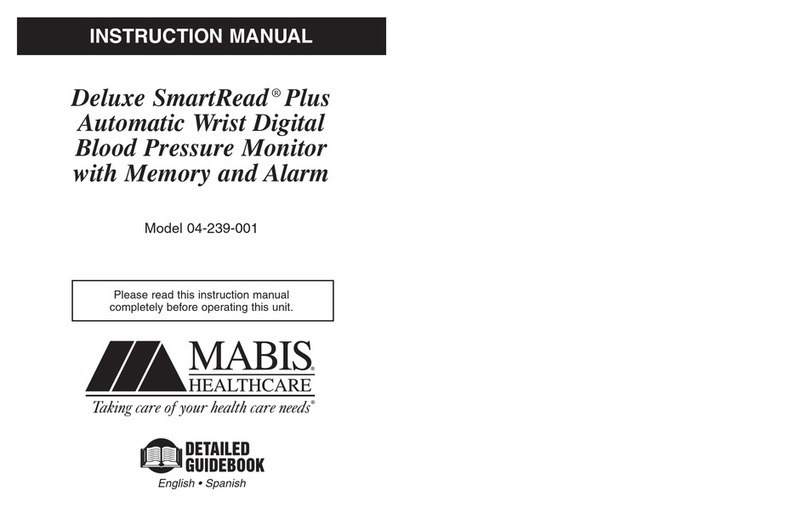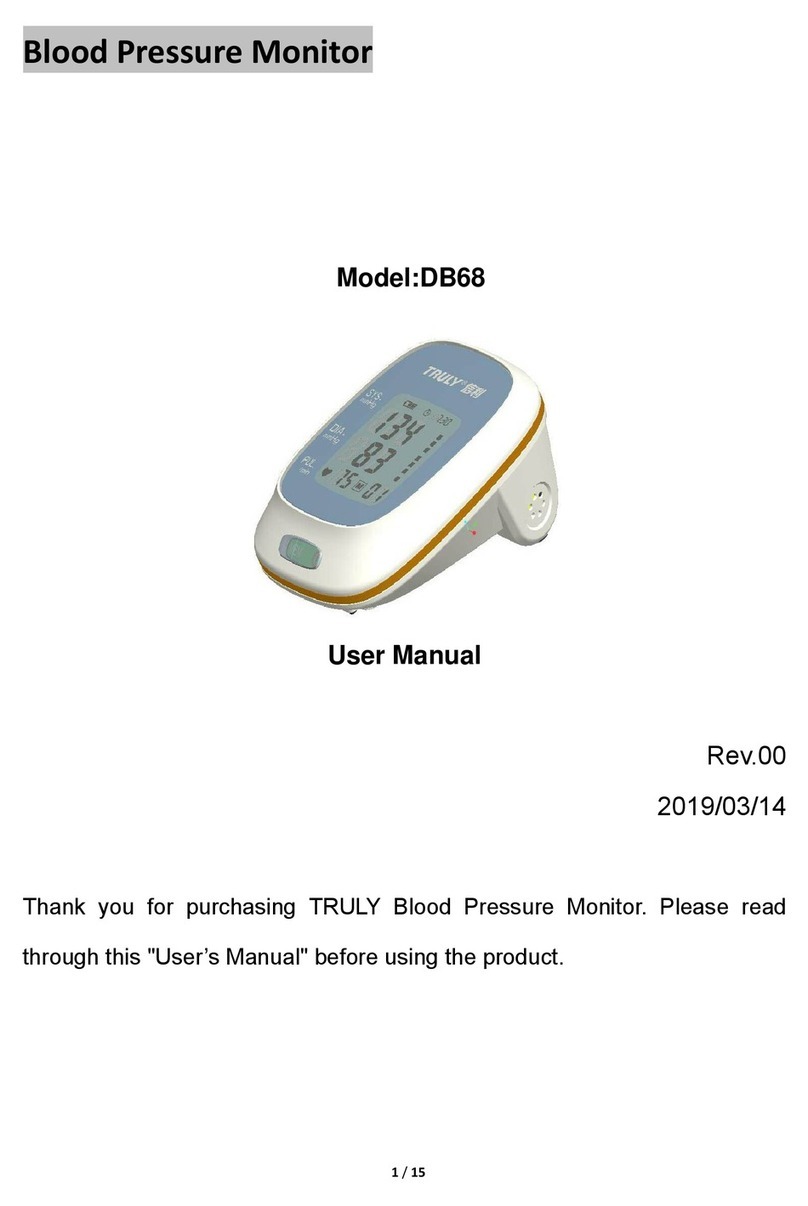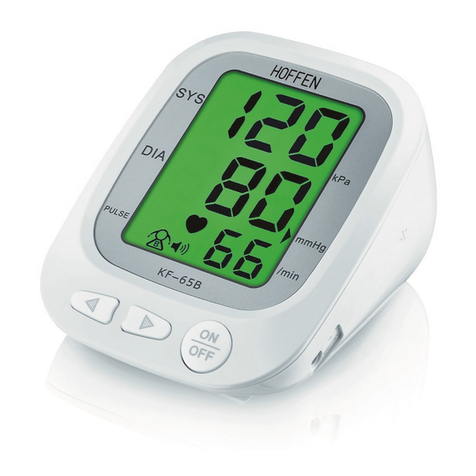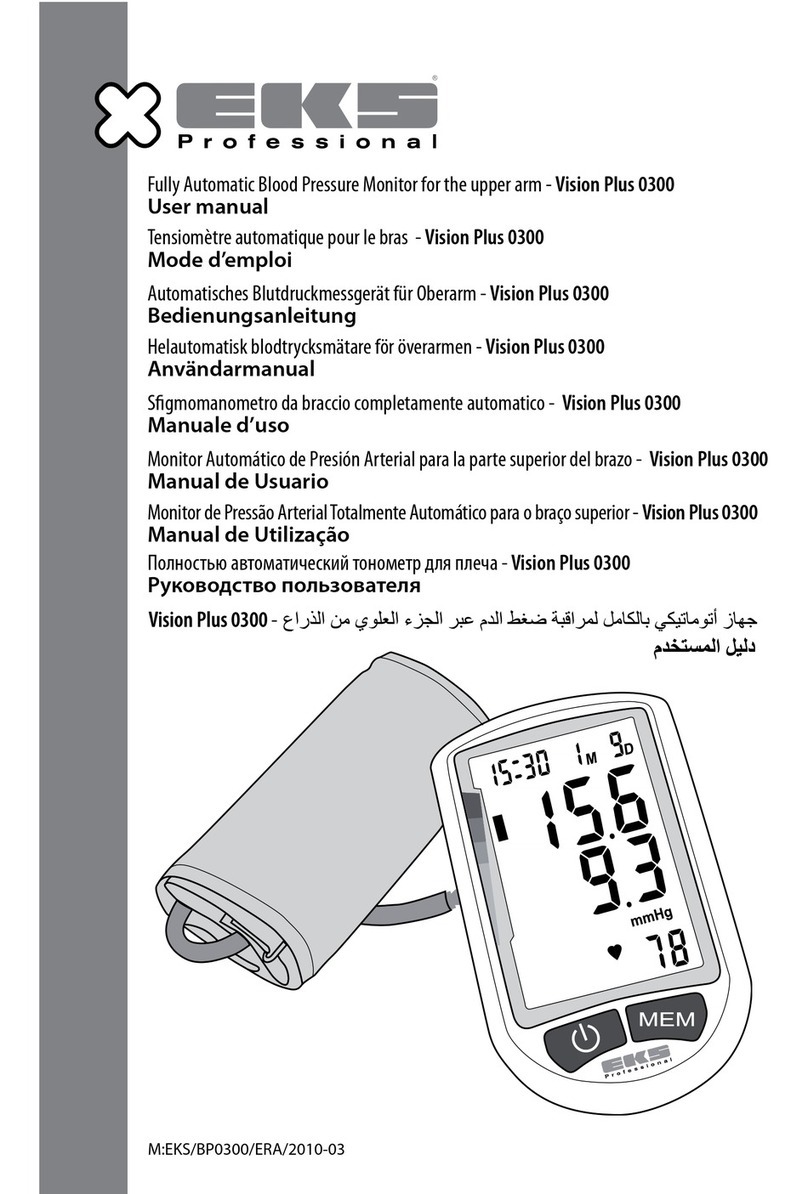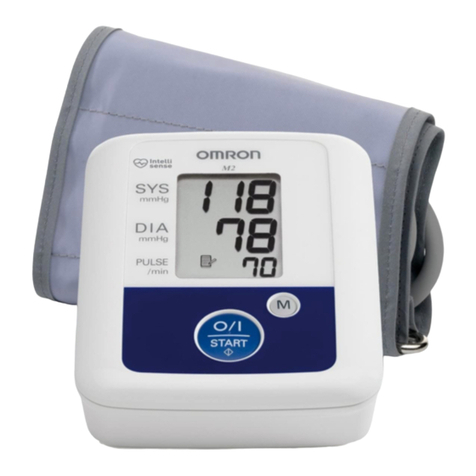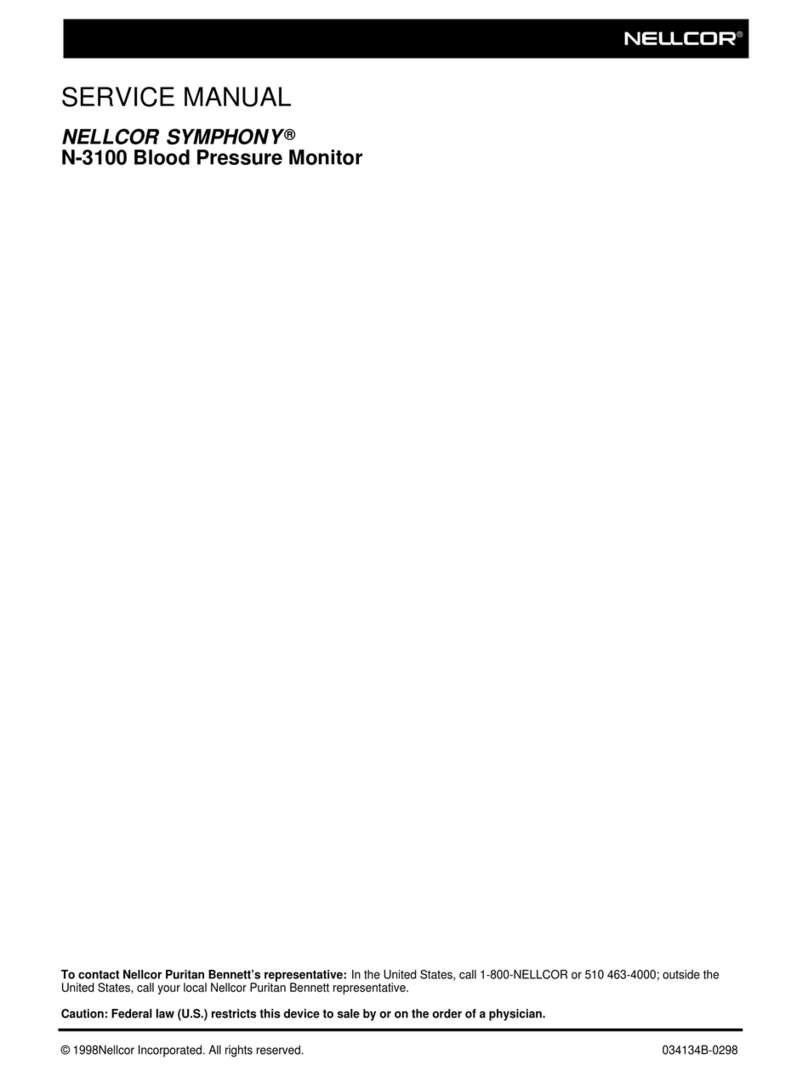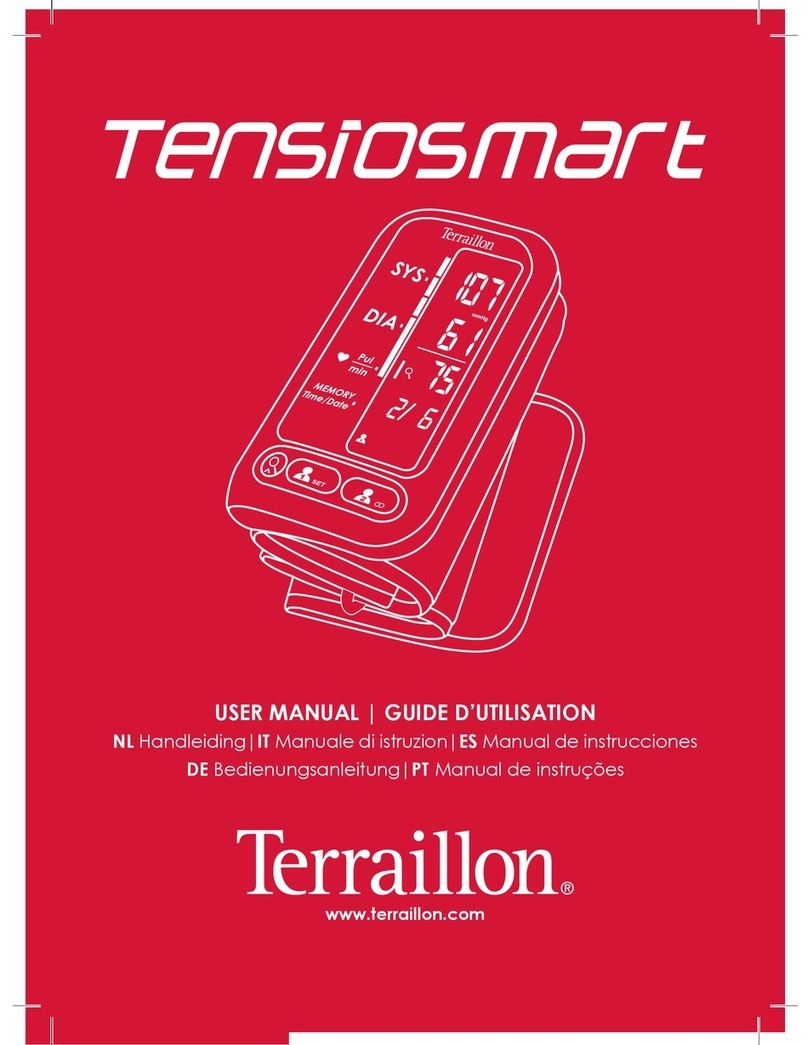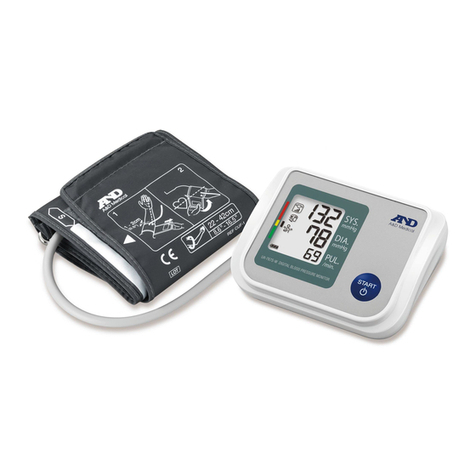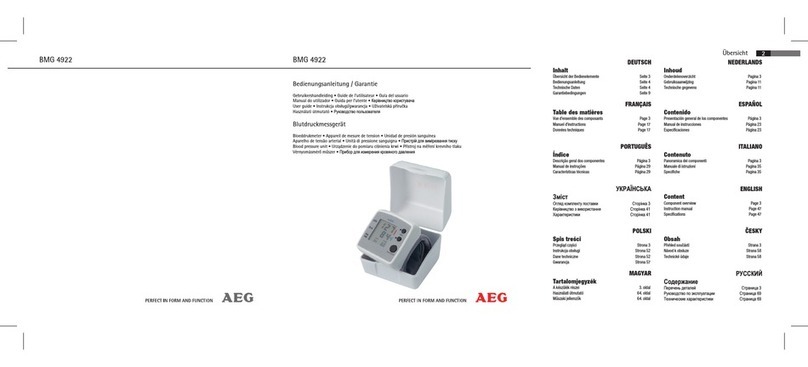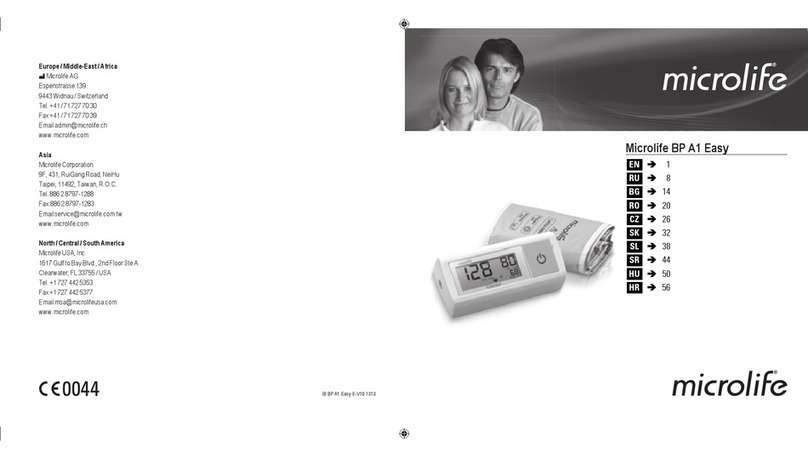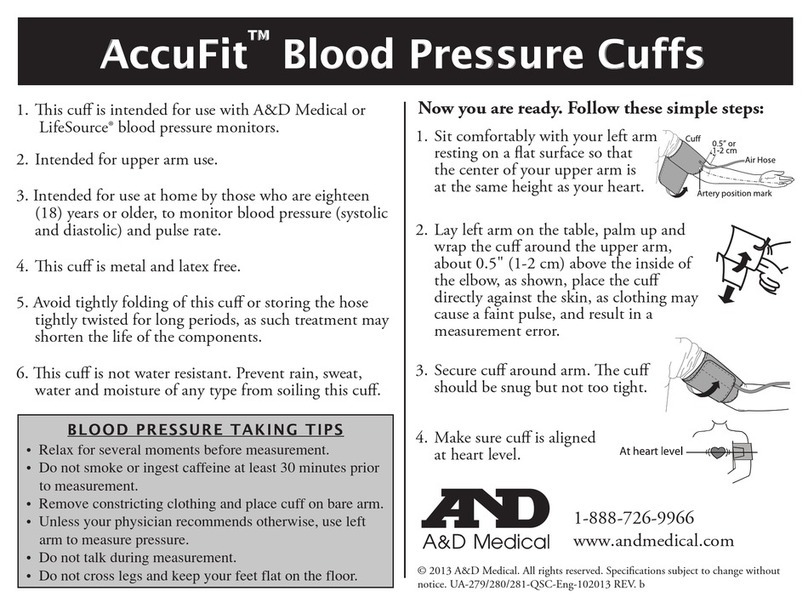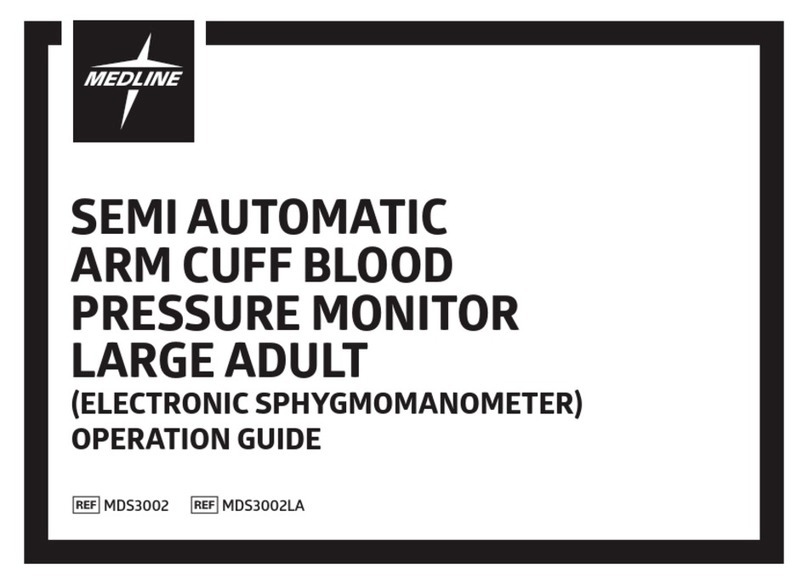Applying Your Blood Pressure Cuff
IMPORTANT: Make sure that the unit is assembled correctly.
Check eartips to make sure they are securely fastened.
1. Sit upright but relaxed in a chair with a back. Keep your feet flat
on the floor. Remove any constrictive clothing from your left arm.
2. Extend your left arm* and have your assistant
find your brachial artery. This is at the inner
aspect your the elbow. Pulse may or may not
be felt.
3. Open the cuff so that you can slide your arm
into it. Do not extend the cuff beyond the
metal bar.
4. With assistance, insert your left arm into the cuff.Position the
bottom edge of the cuff
approximately one-half inch
ABOVE your elbow.
5. With your arm extended,
palm facing upward and
tubes positioned down the
center of your arm, have
your assistant pull the end
of the cuff and secure the
hook and loop material.
6. The cuff should fit comfortably, yet snugly around your arm.
Check for any gaps between the arm and the cuff.
NOTE: *
The left arm should be used unless you are unable to or
should not use your left arm. Consult with your physician to assess
which arm is best for you to use.
Taking Your Blood Pressure Reading
1. Have your assistant insert the eartips into his/her ears. The
metal binaural can be adjusted for comfort.
2. Your assistant should position the stethoscope’s chestpiece over
your brachial artery, directly touching the inside of your arm.
3. Rest your elbow on
a table with your arm
facing upward.
Elevate your hand so
that the cuff is at the
same level as your
heart. Relax your left
hand.
The assistant will:
4. Either hold the gauge or position the gauge so it can be
read without being moved. It can be clipped to the
gauge strap on the cuff for stability.
5. Hold the inflation bulb and turn the air release valve
clockwise to close.
6. Begin inflating the cuff, SLOWLY AND STEADILY,
by pumping the inflation bulb until the gauge reads 30 mmHG
ABOVE your last known SYSTOLIC measurement.
If you do not know your last known SYSTOLIC measurement,
inflate to approximately 180-200 mmHg.
CAUTION: TO PREVENT INJURY TO YOURSELF AND/OR THE
UNIT, NEVER INFLATE THE CUFF ABOVE 280 mmHg.
Taking Your Blood Pressure Reading
6. Upon reaching the proper inflation level, SLOWLY
AND STEADILY, turn the air valve counter clockwise
at a rate of 2-3 mmHg per second.
7. As the pressure begins to drop,
carefully listen for the pulse
beat. Note and record the first
thumping sound heard. This is
your SYSTOLIC pressure.
8. Allow the cuff to continue to
deflate. You will hear changes in
the sounds and then no sound
at all. When you hear the last
sound, note the reading and record. This is your
DIASTOLIC pressure.
9. Rapidly turn the valve counter clockwise to
deflate the remaining air. Remove the cuff and
record the measurement on the recording chart.
NOTE: If you need to take another measurement,
wait a minimum of 15 minutes between readings to allow for the
blood vessels to return to normal. The wait time may vary depend-
ing on your health.
Care and Maintenance
1. Do not wash or moisten the cuff.
2. Avoid dropping or hitting the surface of the gauge or
stethoscope chestpiece.
NOTE: When the cuff is fully deflated, make sure the gauge
needle is at zero (within the zero square). A needle outside the
square means the gauge needs to be recalibrated by a qualified
technician.
As with any other sensitive instrument, the quality and reliability
should be checked annually. In other cases, a gauge will need
maintenance if the needle falls outside the ‘zero square’ on a fully
deflated cuff.Ship your gauge, prepaid along with $5.00 for return
shipping and insurance, to MABIS Healthcare Inc., 1931 Norman
Drive, Waukegan, IL 60085.
Limited One Year Warranty
Your MABIS Home Blood Pressure Kit is guaranteed to be free of
manufacturing defects for a period of one year from the date of
purchase subject to the following terms and conditions:
1. This warranty is limited to the accuracy of the monometer gauge
only. It does not include the inflation system (bulb, valves, cuff
and bladder). During the term of the warranty, MABIS
Healthcare will repair or replace (at their option) any gauge
found to be inaccurate due to normal use. This does not include
gauges that have been misused or abused. This warranty does
not include the cost of replacing any broken parts.
2. MABIS Healthcare shall incur no liability under this Warranty for
any damage from any cause other than inherent manufacturing
defects.
3. ALL IMPLIED WARRANTIES, INCLUDING MERCHANTABILITY
AND FITNESS ARE LIMITED TO THE DURATION OF THIS
WARRANTY. THIS WARRANTY DOES NOT INCLUDE ANY
LIABILITY FOR INCIDENTAL OR CONSEQUENTIAL
DAMAGES.Some states do not allow limitations on how long an
implied warranty lasts or do not allow the exclusion or limitation
of incidental or consequential damages, so the above limitations
or exclusions may not apply to you.
4. This warranty gives you specific legal rights and you may also
have other rights, which vary from state to state.
Quick Start Guide
1) Assemble the contents of your kit.
2) A 15-minute resting period is recommended to stabilize the
body prior to taking a reading.
3) Have your assistant find your brachial artery, which is at the
inner aspect of your elbow.
4) Remove any constrictive clothing or jewelry that may
interfere with the cuff placement. Have the cuff wrapped
snugly around your left arm with the cuff’s bottom edge
approximately 1/2”.
5) Rest your elbow on a table making sure the cuff is at the
same level as your heart.
6) Position the stethoscope’s chestpiece over the brachial
artery.
7) Position the gauge in hand or in a stable, readable location.
8) Have your assistant slowly and steadily, inflate the cuff 30
mmHg above your last known SYSTOLIC reading. If not
known, inflate between180-200 mmHg.
9) At a rate of 2-3 mmHg per second, begin to deflate the cuff.
10) The first ‘thumping’ sound heard is your SYSTOLIC rate.
11) The last sound heard is your DIASTOLIC rate.
12) Record your measurements.
13) A 15-minute rest period is needed between readings to
allow the blood vessels to return to normal.
CAUTION: NEVER INFLATE THE CUFF ABOVE 280 mmHg.
Specifications are subject to change without notice.
#91-176-000 12/04
©2004 MABIS Healthcare Inc.
7 8 9 10 11 12
Note Reading
at First Sound
Note Reading
at Last Sound

